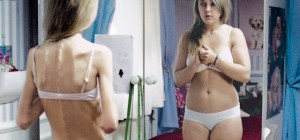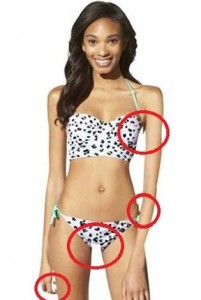Media and its Effect on Body Image

Television, movies, advertisements, music videos, magazines. Society is being exposed to countless forms of media every day. We are being told that we need to look a certain way to be considered beautiful or accepted. We are being taught that in order to be beautiful we need to be unnaturally thin and have perfect hair, perfect skin, perfect teeth, perfect everything. Those people who cannot achieve the ideal standard of beauty will most likely develop a very poor self-image and will resort to things such as extreme dieting, excessive exercise, drugs, eating disorders, and many other unhealthy outlets in order to feel beautiful or accepted. Society has developed an unrealistic standard of beauty that most people cannot achieve, and we need to be aware of its effects on self-image and take steps to ensure that everyone understand the reality of the issue.
Body image is something that the majority of women struggle with. Researchers have come to the conclusion that women’s issues with their physical appearance has become “normative discontent.” This means that almost all women experience body dissatisfaction to some degree. So many women experience this that it has become a normal phenomenon, but society still holds firm to this ideal standard of beauty. There are three theories that explain how and why women develop body dissatisfaction: social comparison theory, cultivation theory, and self-schema theory.
The social comparison theory states that people are likely to compare themselves to people who are similar to them. Whether it is a friend, a celebrity, or someone you go to school or work with, we look at those people and compare many aspects of our lives with theirs. There are two types of comparison: upward comparison and downward comparison. Upward comparison involves a person comparing themselves to someone who they feel is better off than they are, and downward comparison involves a person comparing themselves to someone who they feel is worse off than they are. Media has many opportunities for upward comparison. Women will look at other women in magazines or on television and compare many aspects of their lives. They will develop a desire to be like those women or look like those women which will create a negative image of themselves.
The cultivation theory states that the more often someone is exposed to images of society’s ideal body, the less they are going to realize that those images are unrealistic. We are constantly being exposed to the media and constantly being told what is the most accepted way to look. In a blog posted by Paige Thompson, she says, “For most of my life, I have been bombarded with images of thin women and told by society, through unrealistic expectations about beauty and body image, that I was not beautiful.” Unfortunately for too many people, this statement is all too true. Images of unrealistic women are everywhere, and the more often people are exposed to them, the more they believe that they should look just like them.
The self-schema theory states that women use three points to determine how they view their own body: the socially represented ideal body, the objective body, and the internalized ideal body. The socially represented ideal body points to the way that women are represented in the media. The objective body is how the person views their own body, and the internalized ideal body is the level at which a person internalizes the media’s standard of the ideal body and how much they want to achieve it. If someone is well educated on how unrealistic the media’s portrayal of the ideal body is, they will be able to view numerous images and not internalize them as much as someone who is less educated. However, if someone doesn’t understand this concept, they will be negatively affected and have a very poor self-image.

Magazines are a prime example of how media affects body image. The purpose of magazines is to provide information and sell products to its readers. Most popular magazines today have page after page of advertisements and articles about “all-natural diet pills” and how to get the “perfect beach body.” Over 75% of women’s magazines have at least one statement on the cover of how to change a person’s appearance. In a recent issue of Seventeen Magazine, they featured Troian Bellesario of Pretty Little Liars on the cover. In the article, she talks about how she overcame her eating disorder that nearly ruined her life, yet on that same cover was a headline reading “Get an insane body – it’s hard but you’ll look hot!” Seventeen was promoting a woman who was able to overcome her desire to look a certain way while at the same time telling their readers how they can look “hot.” It is society that sets the standard of beauty, and many will go to extreme measures to meet those standards, such as developing an eating disorder much like Bellisario. For many magazines, it seems to be not so much about helping their readers improve themselves as it is about making as much money as possible, even if that means affecting their readers in a negative way.
Magazine readers are constantly bombarded with images of women who have the perfect tiny waist or long lean legs and who seem perfectly happy and healthy. The reality that most women refuse to accept is that those images are not accurate portrayals of real women. Photoshop has become widely used in magazines and advertisements, and too many people don’t fully understand the degree to which the images they see are digitally altered. As shown in the following video, photoshop can make anyone look like a completely different person.
https://www.youtube.com/watch?v=cPnfjwKfkSk

One recent photoshop scandal involved a target advertisement featuring a model in a leopard bikini with extremely obvious photoshop mistakes. The photographer attempted to increase the gap between the model’s legs by taking out a whole chunk of the swimsuit bottoms as easily seen in the image. The model’s left arm was also slimmed down and resulted in an extra bulge of skin in the underarm. This bikini was advertised as a junior’s piece, which means that many young girls are looking at Target ads and assuming that the images they are looking at are accurate portrayals of the models. Children are exposed to images such as these every day, and too many don’t understand the reality of the photoshop effect.
Children are extremely susceptible to media’s affects. Most young children spend more time in front of a television than they do playing outdoors. Media affects each child differently, but most children are very easily persuaded by everything they see on television, on the internet, or in magazines. Unless they have parents or older role models to teach them the difference between what is real and what is not, they will grow up believing that the images they see in the media are accurate portrayals of real people. According to a recent study, young girls internalize the ideal thin body before they reach adolescence (Sands and Wardle). This goes to show how much effect media has on young children.
Society is not going to change its standard of beauty any time soon, but there are still ways to educate children to make them less susceptible to media’s affects. Parents play a huge role in a child’s life. Many of the things a child learns when they are young, they learn from their parents. It is very important that parents educate their children on society’s standards and how the media portrays beauty. Parents should make sure to monitor what their child is viewing and explain to them the difference between what is real and what is not. It is also important to teach them the importance of being healthy. In a recent study, children were able to recognize the difference between the ideal body and a healthy body. Children would choose a heavier doll to represent a healthy person and a thinner doll to represent the ideal body (Kerkez). Children understand the difference, but they need to be taught how important it is to be healthy. Another very important thing that parents can do is be an example for their children. Parents are very influential people in a child’s life, and many children look to their parents for guidance on how they should behave. If a child sees their mother obsessing with her weight and developing unhealthy habits, they are more likely to do the same.
We are constantly surrounded by movies, television, magazines, music videos, and many other forms of media that are telling us how we should look. We compare ourselves to the countless photoshopped images of bodies that are nearly unattainable and develop a poor self-image as a result. Children are very susceptible to the media’s effect, but with positive role models and parents teaching them the reality of society’s standard of beauty, we can create in them a positive body image and teach them how to live a healthy and happy life.
References
Kerkez, Fatma Ilker. “Perception of ideal and healthy body image among preschool children.” INTERNATIONAL JOURNAL Of ACADEMIC RESEARCH 5 (): 114-119.
Wardle, Jane, and Emma Sands. “Internalization Of Ideal Body Shapes In 9-12-year-old Girls.” International Journal of Eating Disorders 33 (): 193-204.
Leave a Reply
You must be logged in to post a comment.